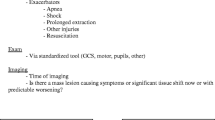Abstract
Severe head injury is the leading cause of death and disability in young adults. It accounts for one quarter to one third of trauma deaths and for a much larger proportion of life long disability after trauma [1]. Neurotrauma constitutes a serious public health problem, requiring prevention and continuing improvement in the care of head injured patients. Currently, in major neurotrauma centers, the mortality rate of severely head injured patients (GCS≤8) is approximately 20 to 25%. The challenge to lower this mortality rate and especially to decrease the rate of disability remains unequivocally high. Clinical and laboratory research have greatly increased our understanding of the pathophysiology of head injury. One of the central concepts is that the primary brain damage, occurring at the moment of impact, initiates a process of secondary events, causing further damage, mainly due to cerebral ischemia. The importance of secondary delayed insults and of changes at the biochemical level is increasingly recognized. The concept of secondary brain damage has led to an interest in developing better monitoring methods, and our improved understanding of changes at the biochemical level has stimulated research into new pharmaceuticals with the potential of inhibiting pathophysiologic processes. Currently, drugs that inhibit lipid peroxidative damage and neurotransmittor-induced secondary damage are being investigated in large multinational randomized clinical trials. Many other drugs acting at various biochemical pathways are being developed and some show promising results in laboratory experiments.
Access this chapter
Tax calculation will be finalised at checkout
Purchases are for personal use only
Preview
Unable to display preview. Download preview PDF.
Similar content being viewed by others
References
Jennett B (1991) Epidemiology of severe head injury: Socio-economic consequences of avoidable mortality and morbidity. In: Scriabine A, Teasdale GM, Tettenborn D, Young W (eds). Nimodipine. Pharmacological and clinical results in cerebral ischaemia. Springer Verlag, Berlin pp 225–233
Ghajar J, Hariri RJ, Narayan RK, et al (1995) Survey of critical care management of comatose head injured patients in the United States. Crit Care Med 23: 560–567
Woolf SH (1993) Practical guidelines: A new reality in medicine. Arch Intern Med 153: 2646–2655
Teasdale G (1991) The treatment of head trauma: Implications for the future. J Neurotrauma (Suppl. 1): S53-S58
Guidelines for the management of severe head injury. The Brain Trauma Foundation (1995)
Graham DI, Laurens AE, Adam JH, et al (1988) Brain damage in fatal non-missile head injury without high intracranial pressure. J Clin Pathol 41: 34–37
Chesnut RM, Marshall LF, Klauber MR, et al (1993) The role of secondary brain injury in determining outcome from severe head injury. J Trauma 34: 216–222
Marmarou A, Anderson RL, Ward JD, et al (1991) Impact of ICP instability and hypotension on outcome in patients with severe head trauma. J Neurosurg 75: S59-S66
Jaggi JL, Obrist WD, Gennarelli TA, et al (1990) Relationship of early cerebral blood flow and metabolism to outcome in acute head injury. J Neurosurg 72: 176–182
Bouma GJ, Muizelaar JP, Stringer WA, et al (1992) Ultra-early evaluation of regional cerebral blood flow in severely head-injured patients using Xenon-enhanced computerized tomography. J Neurosurg 77: 360–368
Marion DW, Darby J, Yonas H (1991) Acute regional cerebral blood flow changes caused by severe head injuries. J Neurosurg 74: 407–414
Santbrink H van, Maas AIR, Avezaat CJJ (1996) Continuous monitoring of brain tissue pO2 in severe head injury. Neurosurg (In press)
Narayan RK, Kishore PR, Becker DP, et al (1982) Intracranial pressure: To monitor or not to monitor? A review of our experience with severe head injury. J Neurosurg 56: 650–659
Editor information
Editors and Affiliations
Rights and permissions
Copyright information
© 1996 Springer-Verlag Berlin Heidelberg
About this paper
Cite this paper
Maas, A.I.R. (1996). Guidelines for Management of Severe Head Injury in Adults. In: Vincent, JL. (eds) Yearbook of Intensive Care and Emergency Medicine. Yearbook of Intensive Care and Emergency Medicine, vol 1996. Springer, Berlin, Heidelberg. https://doi.org/10.1007/978-3-642-80053-5_57
Download citation
DOI: https://doi.org/10.1007/978-3-642-80053-5_57
Publisher Name: Springer, Berlin, Heidelberg
Print ISBN: 978-3-540-60552-2
Online ISBN: 978-3-642-80053-5
eBook Packages: Springer Book Archive




